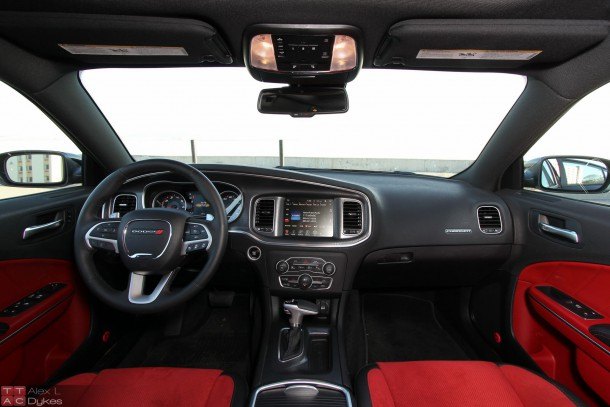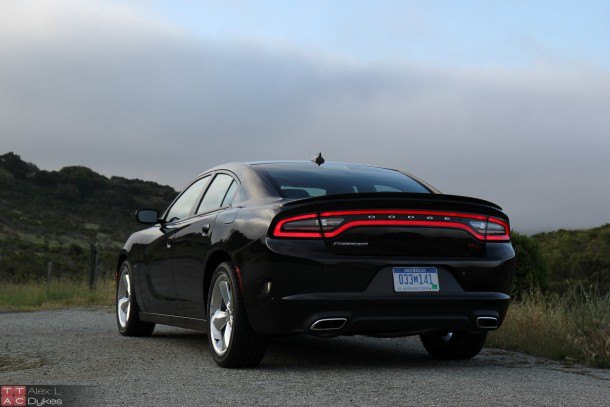2015 Dodge Charger R/T Road and Track Review (With Video)

The first car I bought new was a 2000 Chrysler LHS. (I single handedly lowered the model’s average age demographic.) It was the very pinnacle of Chrysler’s Iacocca turn-around. It was large, competitive and made from Chrysler’s universal parts bin. Then Mercedes came on the scene promising to “synergize” product development with their luxury brand. The plan had a promising start with the 300 HEMI C concept, but the production reality was a big sedan with a plastacular interior and Mercedes hand-me-down parts.
Now that Mercedes and Chrysler have divorced, we’re starting to see what a real German-American synergy looks like. For 2015, the Dodge Charger has gone under the knife to look leaner and meaner with a new German transmission. Like my 2000 LHS, this may just be the pinnacle of the Marchionne turn around. It’s big, it’s bold and it’ll make you forget why you stopped to look at that Toyota Avalon last week.
Identify the Competition
Exterior
Interior
FCA reps said that no changes were made to the seat cushion design for 2015, but our tester lacked the pronounced hump found in the 2012 model we last tested, an issue that make me feel like I was sitting on a very large gumdrop.
In a car this big, you’d expect a big booty, but the smallish trunk lid foreshadows the decidedly mid-size trunk at 15.4 cu-ft, 7 percent smaller than a Ford Fusion’s cargo spot and only 15 percent bigger than that of the compact Ford Focus. In general, the full-size car label no longer guarantees large luggage capacity. So, on paper, the Charger’s smallish trunk is fairly competitive with the likes of the Toyota Avalon (14.4) but the Taurus’ ginormous booty will schlep 25 percent more warehouse store bagels. The rear seats fold down to reveal a large pass-thru and the wide and fairly flat rear seats make three baby seats across a tight but entirely doable adventure.
Drivetrain
Unlike the competition, the Charger offers some more powerful engines to choose from. Scroll down the spec sheet and you find not one, not two, but three different V8s on offer. R/T and R/T Road and Track trims get the popular 5.7L V8 good for 370 hp / 395 lb-ft, R/T Scat Pack and SRT 392 models make do with a 485 hp / 475 lb-ft 6.4L V8, and if you want to throw caution to the wind there’s a 6.2L supercharged V8 making a whopping 707 horsepower.
Last year most models had the old Mercedes 5-speed automatic with just some trims getting the new ZF-sourced 8-speed. This year every Charger gets the 8-speed and the difference is eye-opening.
For those of you unfamiliar with the transmission world, ZF is a German company that makes transmissions and licenses transmission designs for a wide variety of performance and luxury cars. You’ll find ZF transmissions lurking under the hoods of twin-turbo V12 Rolls Royces, inline-6 BMWs and AWD Audis, so the Charger is rubbing elbows with some classy company.
Performance
Let’s tally this up so we keep this in perspective. The V6 is now competitive with the competition and the 5.7L V8 is now a hair faster than the SHO. What makes the Charger crazy is we still have two engines left. Add the Scat Pack to the R/T, or choose the SRT 392 and acceleration drops to 4.2-4.3 seconds as long as the tires can find grip. The Hellcat, as I’m sure you’ve heard, is the fastest production sedan with a blistering 2.9 seconds to 60 if you are willing to wear racing slicks and put your life on the line.
An interesting note of trivia is that Charger Pursuit police cars still get ye olde 5-speed with both the 3.6L and 5.7L engines. The reason likely has more to do with the 5-speed automatic’s column mounted shifter in Pursuit guise than any durability benefit.
Drive
Under-tired doesn’t translate to less fun – quite the opposite in my book. In fact, the Charger reminded me of the base Mustang and FR-S. Confused? Toyota’s mission with the FR-S was supposed to be a car to explore RWD dynamics without breaking the bank. Know what? That’s actually the Charger. Starting at $27,995, it’s only $1,000 more than an automatic FR-S and $2,000 more than a V6 Mustang with the auto. Unlike the FR-S, you get a power seat, dual-zone climate control, the 7-inch LCD in the gauge cluster, a much snazzier radio, three extra gears in your transmission and usable back seats. Will it dance around an autocross track like an FR-S? No, but you have almost as much fun and still use the car on the school run. Our R/T Road and Track tester was the same sort of thing taken to the next level.
All versions of the Charger deliver a civilized ride thanks to the well designed suspension and a long wheelbase as much as the size and weight of the vehicle. As with all modern cars, electric power steering sucks some of the fun out of the RWD platform, but the boost is adjustable. And because the front wheels are only responsible for steering, you get considerably more feedback than in the FWD or AWD competition. Despite the heft, braking fade was well controlled, although distances are a little longer than I’d like due mostly to the tire sizes involved.
Compared to the SHO, the Charger has a more polished ride. The SHO has an enormous trunk and a more accommodating back seat. The SHO is all-wheel-drive which gives you better traction, but the Charger has better weight balance and more accurate feel on the road. Compared to the FWD competition, the Charger feels more substantial out on the road, more precise and certainly handles the corners with less drama. There’s no torque steer and surprisingly neutral handling even in the heavier 6.4L models.
At $42,265, our model as tested managed to be $1,000 less than a comparable Avalon Limited, $2,000 less than a Cadenza Limited and, although it was slightly more expensive than the Taurus SHO, it had about $1,800 more equipment. The Charger’s discount price tag honestly surprised me. I had expected our tester to be a few grand more than the SHO.
What should you buy?
FCA provided the vehicle, insurance, and one tank of fuel for this review.
Specifications as tested
0-30: 2.05 Seconds
0-60: 5.0 Seconds
1/4 mile: 13.3 @ 114
Average fuel economy: 19.5 MPH over 678 miles

More by Alex L. Dykes
Latest Car Reviews
Read moreLatest Product Reviews
Read moreRecent Comments
- ChristianWimmer It might be overpriced for most, but probably not for the affluent city-dwellers who these are targeted at - we have tons of them in Munich where I live so I “get it”. I just think these look so terribly cheap and weird from a design POV.
- NotMyCircusNotMyMonkeys so many people here fellating musks fat sack, or hodling the baggies for TSLA. which are you?
- Kwik_Shift_Pro4X Canadians are able to win?
- Doc423 More over-priced, unreliable garbage from Mini Cooper/BMW.
- Tsarcasm Chevron Techron and Lubri-Moly Jectron are the only ones that have a lot of Polyether Amine (PEA) in them.
















































































Comments
Join the conversation
"rubbing elbows with some classy company." Well put, you're really getting into the mindset of the Charger owner here.
Here's my main issues with this car (same issues as the first generation) putting aside the people who buy them. -Door handles look extremely cheap, plain, and old to my eyes, like they're off an old Cirrus or something. http://images.gtcarlot.com/pictures/38784576.jpg -Side trims on the window are both too chunky (reads cheap and unbalanced) and matte. Draws the attention to the overall shape of the side windows, which is not necessary in a car this shape when it's got plenty of other interesting details going on.